 |
Posted on 01/20/2004 7:24:59 AM PST by Maximilian
|
As soon as I heard of Ken Jones' Index of Leading Catholic Indicators,1 I had an intense desire to purchase a copy. The 113-page paperback book contains statistics relating to all aspects of Catholic life: Catholic education, religious orders, Catholic practice and belief, seminarians, nuns, and diocesan priests. Having read the Index, my compliments go out to Mr. Jones. Like myself, Mr. Jones is the father of seven young children, so I understand the sacrifice it was for him to take the time to bring this important information together. He has done an excellent job of presenting clear, irrefutable, unbiased, and undeniable raw data pertaining to the crisis in the Church, and he also provides some important analysis of that data. It is important work, and it is solid evidence supporting what many of us have known for a long time.
Poring over page after page of bar charts, graphs, and tables in the Index, one cannot help but be overwhelmed by the sense of loss. In every category — religious orders, diocesan priests, religious priests, teaching orders, you name it — the decline is sharp, obvious and undeniable.
Being a mathematician, however, I was not content to just read his book cover to cover. Mr. Jones' analysis was good, but he did not view his data the same way a mathematician does. Instantly I saw linear functions, exponential functions, and patterns that we can use to model and make predictions. The numbers, bar charts, figures and statistics gave me a level of excitement and an adrenalin rush that most would have to turn to bungee jumping to achieve.
At the sight of the tables of data, I reached for my computational tools: Maple 8.0, Sigma Plot, SPSS for Windows, and my trusty old Texas Instruments TI-85. Initially I was not sure where to begin, but after careful consideration, I concluded that the most important statistics are those having to do with seminarians. Seminarians are the future of the Church; without priests we will become a different Church. Godfried Cardinal Danneels of Belgium stated in an interview with the Catholic Times in May 2000 that "Without priests the sacramental life of the Church will disappear. We will become a Protestant Church without sacraments. We will be another type of Church, not Catholic." Already we can see this bleak prediction coming to pass as one parish after another is turned over to "Lay Administrators." So the chart having to do with the total number of seminarians2 throughout the better part of the last century is the most significant to us as Catholics.
Now, an initial glance at the bar chart titled "Total Seminarians" seems to indicate that there are essentially two functions: one linear and one exponential. The period prior to 1965 shows a linear increase and the period from 1965 to the present shows an exponential decrease.
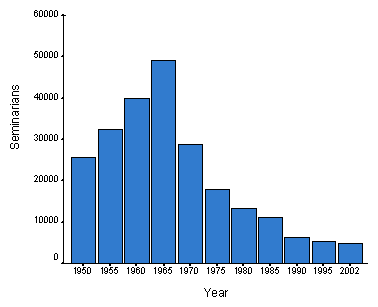
We begin our analysis by plotting the graph for the period prior to 1965. This period was one of steady growth, so I found that we could roughly match it with a line of slope 829.331. This means that each year that passed there were approximately 829.3 seminarians more than there had been the previous year. So every ten years there were approximately 8,293 seminarians more than there had been the previous decade.
The growth rate over this period can be expressed as P (for "Preconciliar Growth Rate") as a function of time t, where t is in years and t = 0 in 1920:
![]()
Or, expressed as a function of the year:
![]()
Where the value of year can range from 1920 to the year 1965.
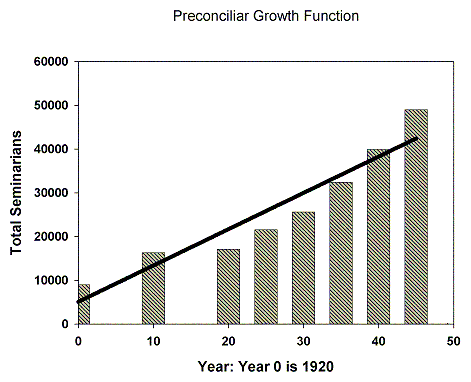
The growth was actually not perfectly linear, as we can see; in fact it was beginning to accelerate into what appears an exponential growth in the final years from 1940 to 1965. However, let's assume the worst — that the growth had just continued at the linear rate described by P(year). Then the number of seminarians we could have had in the year 2003 would have been approximately:
![]()
So, had this growth rate continued, by the year 2003 we would have a total of approximately 73,927 seminarians instead of the current figure of less than 5,000. Below you will see the actual data, and superimposed on it is a projection of P(year), the Preconciliar Growth Function, extending through the year 2002.
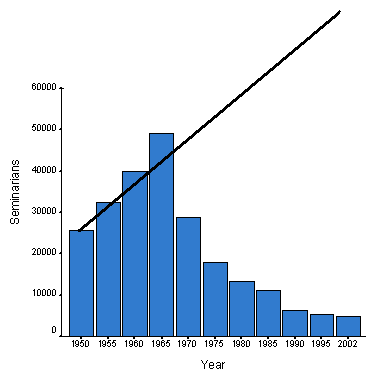
It is clear that the period from 1965 onward is nonlinear, so a different technique is required for modeling this period. The exponential decrease from 1965 onward appears similar to a graph of radioactive decay; as it turns out, this period can be modeled by what is commonly called an exponential decay function. Since this period of the Church is commonly called the "Springtime," we shall refer to this function as the Springtime Decay Function S(t), where S, the Springtime Decay, is a function of time t. We begin by taking the log of each of the data points. This gives us an essentially linear data set, to which we can match a line as we did previously for the Preconciliar Growth Function. Now we exponentiate both sides of our equation obtaining the following function:
![]()
Or, expressed as a function of the year:
![]()
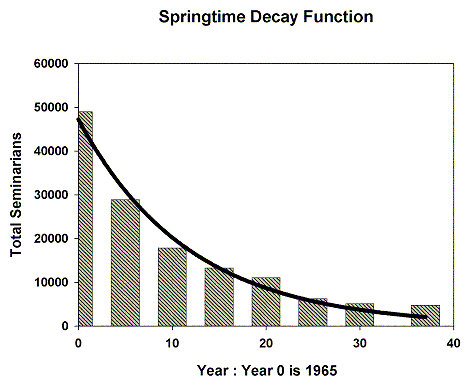
Applying this model we can see that by the year 2065, 100 years from the beginning of the Springtime Decay process, there will be a total of 10 seminarians in the United States. The half-life of this process is 8.19 years, the approximate period of time it takes for the number of seminarians to diminish by ½.
There are some who will argue that this model does not apply. The last two actual data points are higher than the exponential decay function; certainly, according to some, this means that the decline is over, and that all will be back to normal soon. This is wishful thinking, but to accommodate them we turn to the modified exponential decay model. The Modified Springtime Decay Function is not as simple, but it is more accurate:
![]()
Or, expressed as a function of the year:
![]()
According to this modified decay function there will be 779 seminarians in the year 2065 instead of the 10 predicted using the previous model.
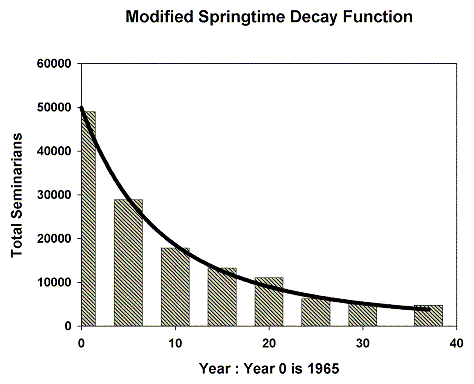
We can obtain a rough estimate of the number of lost vocations by taking the sum from 1965 to the present, in five year increments, of the difference between P(year) and S(actual), where the values for S come from the actual data in Mr. Jones' Total Seminarians table.
![]()
This estimate makes two assumptions:
We obtain the following values for each year:
| Year | P(year) | S(actual) | Difference |
|---|---|---|---|
| 1970 | 46,560 | 28,819 | 17,741 |
| 1975 | 50,706 | 17,802 | 32,904 |
| 1980 | 54,853 | 13,226 | 41,627 |
| 1985 | 59,000 | 11,028 | 47,972 |
| 1990 | 63,146 | 6,233 | 56,913 |
| 1995 | 69,293 | 5,083 | 62,210 |
| 2002 | 73,098 | 4,719 | 68,379 |
| TOTAL: 327,746 | |||
According to this rough estimate, approximately 17,741 vocations were lost over the first five-year period, 32,904 were lost over the second five-year period, etc., for a total of 327,746 since 1965.
There is no formula available for the calculation of the number of souls lost as a result of this loss of vocations.
There is one additional set of data that was not included in the Index, and that is data relating to the increasing number of vocations found through the "Traditional" Catholic seminaries, or those seminaries in which the 1962 rite is followed and priests are formed according to preconciliar standards. At the moment these seminaries are relatively new, but the growth is impressive. I was unable to obtain any statistics on the Institute of Christ the King, Sovereign Priest, which has a small presence in our country, but the figures for the graph below were provided courtesy of Fr. James Jackson, rector of Our Lady of Guadalupe Seminary in Denton, Nebraska. Our Lady of Guadalupe, where priests of the FSSP (Fraternitas Sacerdotalis Sancti Petri, or Priestly Fraternity of Saint Peter) receive their formation, is now in its twelfth year. Since their move from Pennsylvania to Nebraska four years ago they have been operating at maximum capacity. This fall, Academic Year 2003-2004, as in previous years, they had to turn away a large number of candidates due to lack of room in the partially completed seminary.
The noticeable gap at year eight was during their move from Pennsylvania to Nebraska.
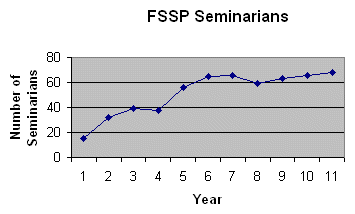
Many have asserted that the sudden decline in all aspects of Catholic life that began in 1965 was due to "other factors," such as the influence of "the sixties." But Mr. Jones soundly refutes that argument by including a simple chart3 which shows a marked decline in Church attendance among Catholics from the 1960s to the present while it remained virtually level, with a slight increase, for Protestants. To more fully understand the nature of the crisis we find ourselves in, I highly recommend that every Catholic capable of reading beyond an eighth grade level purchase a copy of the Index and study it.
It is clear from this brief analysis of the data relating to the number of seminarians over the past eighty years that several things are true:
Although we cannot know the will of God, we can ponder the significance of the following:
The author, a retired Lieutenant Colonel in the United States Army, teaches Computer Science and Mathematics at Lyon College in Batesville, Arkansas where he resides with his wife and seven children.
Boy, did I see that coming.
No one hates America like you do except for a European.
I'm really suprised by your simplistic pigeon-holing. What evidence do you have that indicates Euopeans hate America?
My mother is an immigrant from Europe. Many Europeans are full of condescending remarks about America while in the next breath they beg to come to America to visit or work.
I hear this firsthand in phone calls from my mother's extended family and friends. We hosted a friend's daughter back in August. She was hell on wheels. She wanted to move to America to find work, particularly in California. But, she was ungrateful, condescending and insulting beyond belief. She burned all bridges in this community. No one will host her again.
The similiarity, is that neither Hitler's , nor Saddam's genocidal activities against indiginous populations were cited as reasons to invade. America's role in ending the Holocaust and Saddam's practices have been glorified to enhance America's self-image as the saint-nation, and this image is trotted out in all it's lack of perspective any time someone dares to bring into question the real consequences of America's military exploits.
You are welcome to move. No one is forcing you to live in this country.
This is hate? I've never heard of anti-semites wanting to move to Israel. Sounds more like immaturity, hypocrisy, homesickness, culture-shock, bad manners. I can't recognize hate in your tale.
The Europeans I have met don't hate America; some liberals may disagree with our government's policies ( so do American conservatives ), or some find our culture unsatisfying, or even our cuisine unappetizing (sounds like my opinion of England ), but hatred is much too strong a word to fling about. Contrary to my critical rhetoric and my polished avoidance skills, I do not hate my in-laws.
Oh brother. Thanks for revealing what kind of person is attracted to the SSPX.
I would consider that as compliment to you, Deborah.
It's funny that the SSPX heirarchy that you respect so much would fall under the aegis of America haters, as their position on the war is identical to the pope's.
I've been trying to get at what you mean by calling someone an America hater/European. I guess it's just arbitrary and doesn't really mean anything. Never mind.
Its a matter of eliminating all the liturgical mischief of Bugnini and Antonelli, who started their work in 1950 with the destruction of the office of the Assumption. Nothing more was implied by it than this.
No Deb. You made the accusation. You back it up. Be a woman about it, don't run away like a sissygirl.
Unless you're just looking to pick a fight.
Excuse me, but you are the one flinging highly volatile epithets around. If anyone is picking a fight, I'd say its you.
Retract or lay out a case.
Listen newbie. My relatives fought and bled in every war from the War of Spanish Succession up through Vietnam so that you would have a country to come to here. You've got a country here because we came over the sea when there was nothing in the 1600 and 1700's, cleared land, built roads and homes and mines and railroads and spaceports, fought wars, founded a country, served the country in war and peace in the military and in elected public service. We've been here long enough that we have towns and mountains and the like named for our family - because we founded them or discovered them.
So its a little galling to hear some johnny-come-lately rabble barely off the boat accusing ME of not loving MY country. MY country because MY family did not immigrate here - MY family helped to found it and build it. YOUR family was allowed to come over here because people like MY family were gracious enough to allow you in to what is OURS. Got it? Don't forget it.
Disclaimer: Opinions posted on Free Republic are those of the individual posters and do not necessarily represent the opinion of Free Republic or its management. All materials posted herein are protected by copyright law and the exemption for fair use of copyrighted works.